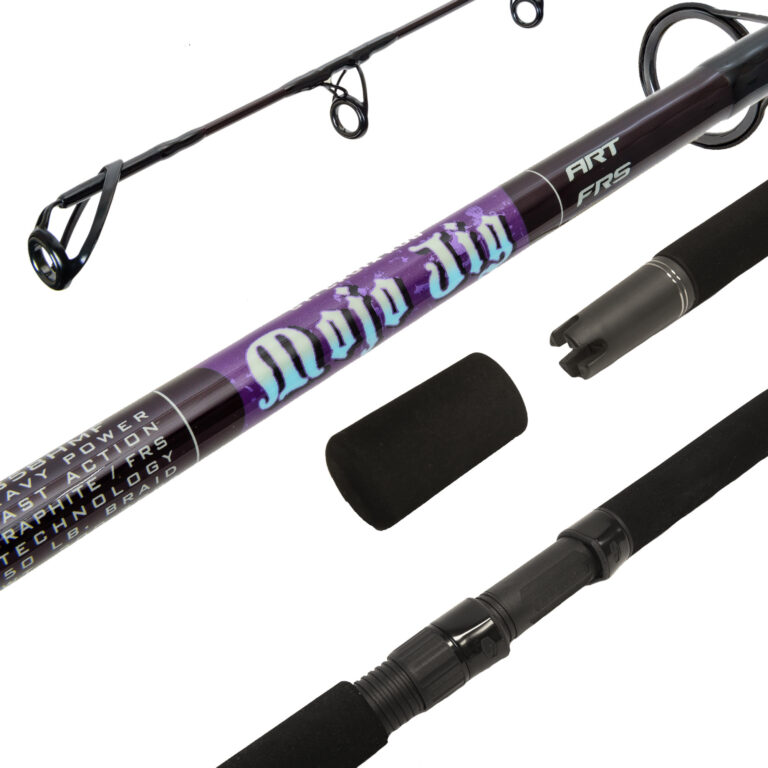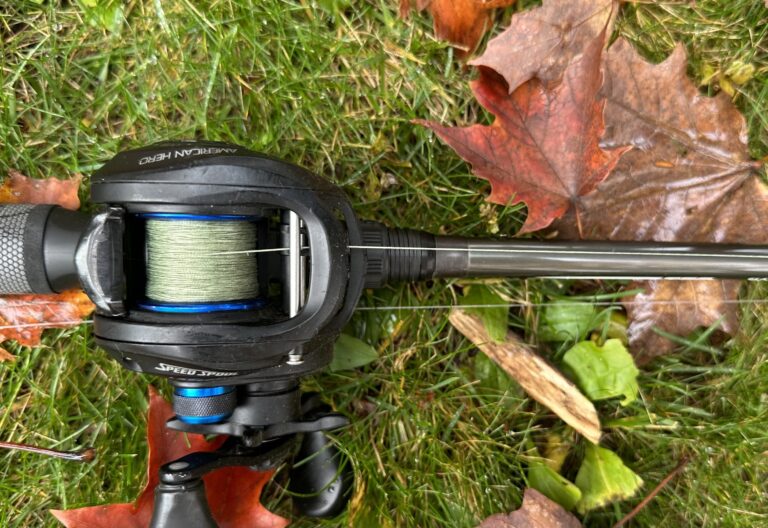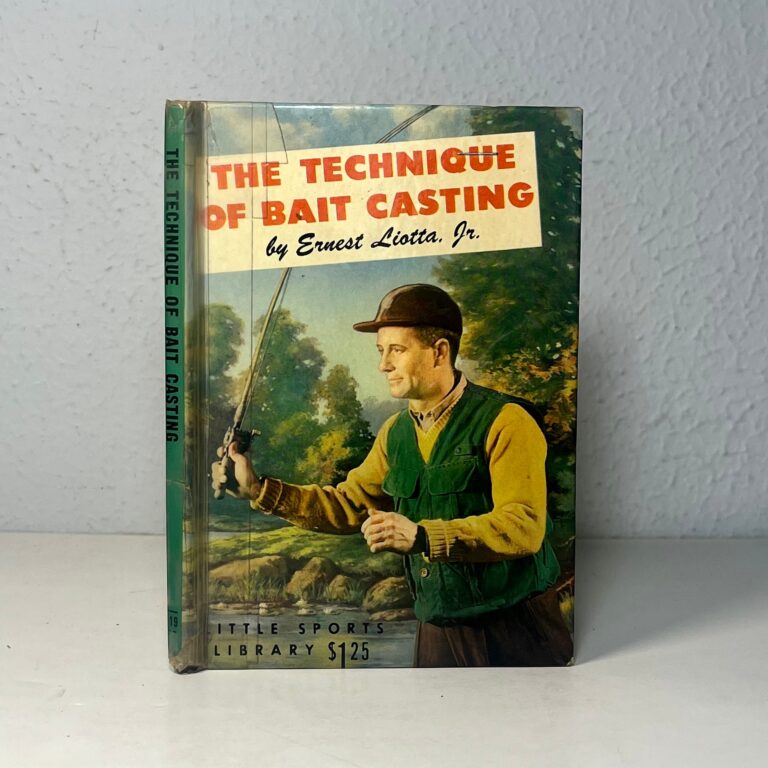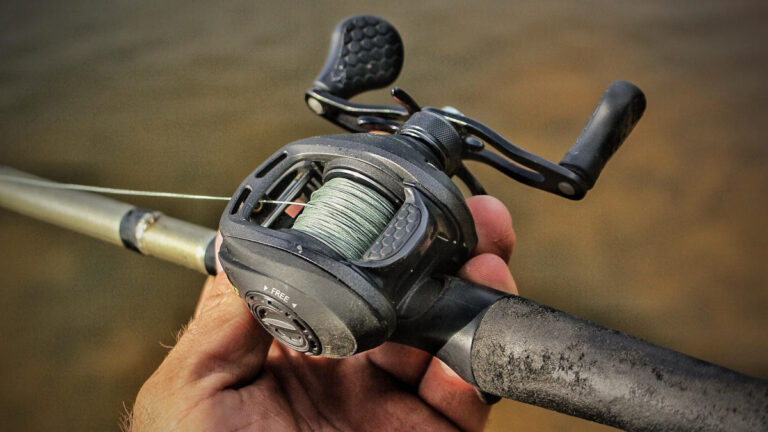The main difference between a round baitcast reel and a low profile baitcast reel is their size and shape. Round baitcast reels have a larger, circular shape, while low profile baitcast reels are more streamlined and compact.
Baitcasting reels are essential tools for anglers looking to target larger fish species. When choosing a baitcast reel, one of the decisions to make is whether to go with a round baitcast or a low profile baitcast reel. Understanding the differences between these two types will help you make an informed decision based on your fishing style and specific needs.
Round baitcast reels have a traditional design with a circular shape, providing increased line capacity and a more powerful drag system. On the other hand, low profile baitcast reels offer a more ergonomic and compact design, making them lighter and easier to handle for extended periods. This article will delve into the features, advantages, and drawbacks of round and low profile baitcast reels to help you choose the most suitable option for your fishing endeavors.
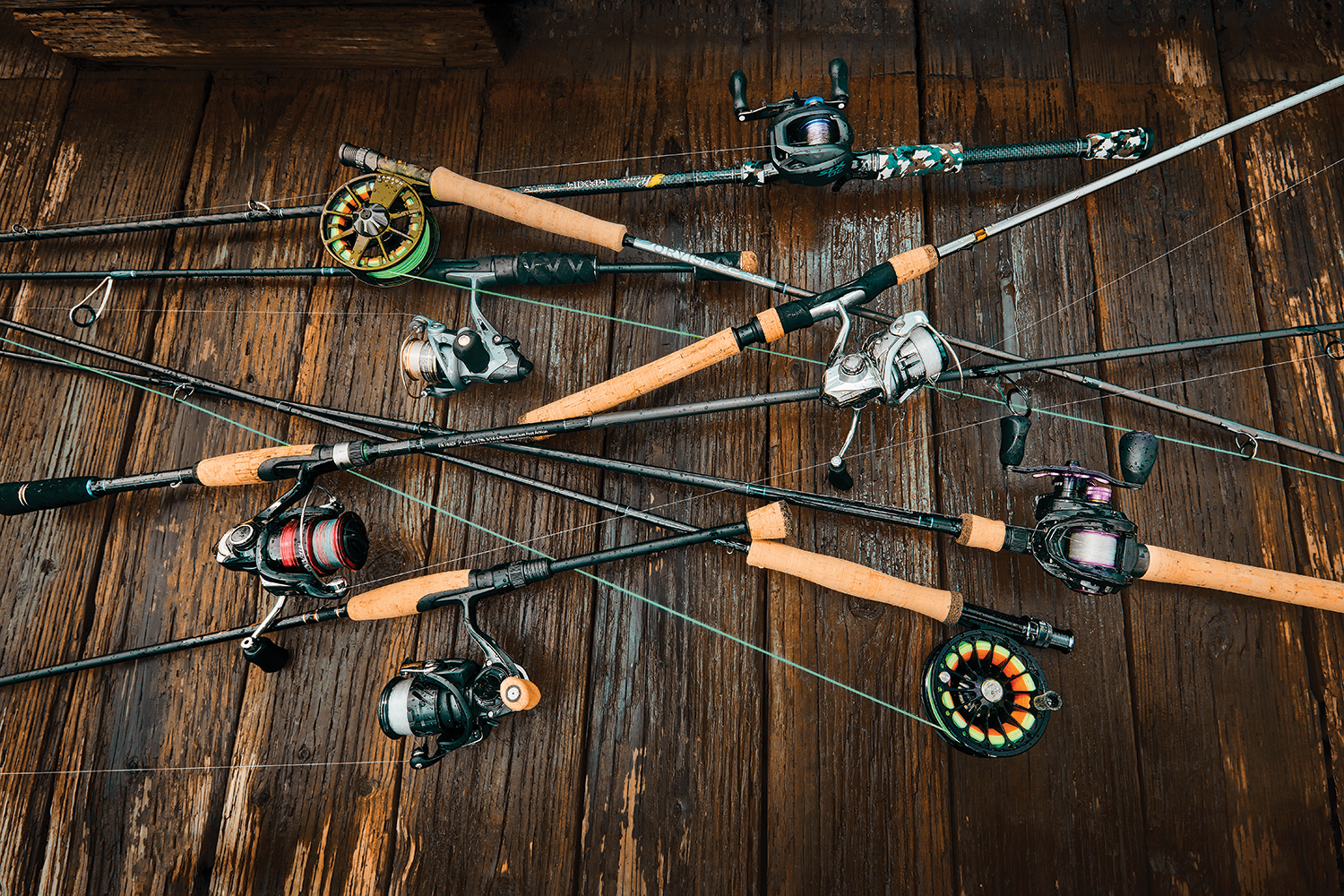
Credit: www.outdoorlife.com
Understanding The Difference: Round Baitcast And Low Profile Reels
When it comes to choosing the right fishing reel for your needs, it’s essential to understand the differences between various types. In this section, we will explore the differences between round baitcast and low profile reels, highlighting their key features and explaining how their design impacts performance.
Let’s dive in and discover which reel type may be best suited for you.
Exploring The Different Reel Types
Round baitcast reels:
- Known for their classic design and durability.
- Typically larger and heavier than low profile reels, making them suitable for targeting larger species.
- Offers greater line capacity, allowing anglers to reel in bigger fish without worrying about running out of line.
- Often preferred for offshore and saltwater fishing due to their capacity to handle heavier lines and lures.
- May take some time to master casting techniques, as they can be more prone to backlash for beginners.
- Designed with a rotating spool that requires more thumb control during casting.
Low profile reels:
- Feature a sleek and compact design, making them lightweight and comfortable to use.
- Popular among anglers who enjoy fishing for bass and other freshwater species.
- Offer better ergonomics and feel in hand, minimizing fatigue during extended fishing sessions.
- Enable precise and accurate casting due to their advanced braking systems.
- Typically have a lower line capacity compared to round baitcast reels, limiting their suitability for targeting larger fish or fishing in heavy cover.
- Often preferred for finesse fishing and casting smaller lures with greater accuracy.
Key Features Of Round Baitcast Reels
- Robust build quality: Round baitcast reels are designed to withstand the toughest fishing conditions, making them a durable choice for anglers.
- Greater line capacity: These reels can hold a significant amount of fishing line, allowing anglers to target larger fish and engage in offshore or saltwater fishing.
- Suitable for heavy-duty fishing: With their sturdy construction and ability to handle heavier lines and lures, round baitcast reels are ideal for anglers seeking robust gear for big game fishing.
Key Features Of Low Profile Reels
- Lightweight and ergonomic design: Low profile reels are designed to be compact and comfortable, reducing fatigue during long fishing trips.
- Enhanced casting accuracy: These reels are equipped with advanced braking systems, facilitating precise and accurate casting, especially when using smaller lures or finesse fishing techniques.
- Preferred for bass fishing: Low profile reels are a popular choice among bass anglers due to their lightweight design and ability to perform well in freshwater environments.
How The Design Impacts Performance
Round baitcast reels:
- The larger and heavier design of round baitcast reels provides extra power and line capacity, making them suitable for catching larger fish and fishing in deep waters.
- The rotating spool design may require more thumb control during casting to prevent backlash.
Low profile reels:
- The sleek and compact design of low profile reels allows for better ergonomics and comfortable handling. This design also reduces the overall weight of the reel, making it ideal for anglers who prefer lightweight gear.
- The advanced braking systems in low profile reels enable anglers to achieve precise and accurate casts, ensuring greater control over lure placement.
Whether you’re targeting big game fish or enjoy finesse fishing for bass, understanding the key features and design differences between round baitcast and low profile reels is crucial in selecting the right reel for your fishing adventures. Each type has its strengths and weaknesses, so weigh your preferences and the fishing conditions before making your final decision.
Pros And Cons Of Round Baitcast Reels
Round baitcast reels are a popular choice among anglers, particularly those who engage in heavy-duty fishing. These reels offer several advantages that make them stand out from their low profile counterparts. If you’re considering investing in a round baitcast reel, it’s essential to understand the pros and cons.
In this section, we’ll discuss the advantages and disadvantages of round baitcast reels.
Advantages Of Round Baitcast Reels
Round baitcast reels offer a range of benefits that make them well-suited for specific fishing scenarios. Let’s delve into the advantages of using these reels:
- Increased line capacity for heavy-duty fishing: Round baitcast reels typically have a higher line capacity compared to low profile reels. This feature is advantageous when you’re targeting larger fish species or engaging in heavy-duty fishing. It allows you to use thicker lines, increasing your chances of successfully reeling in your prized catch.
- Enhanced stability and control: Round baitcast reels excel in providing stability and control, especially when casting heavier baits. The round shape of the reel and its design contribute to improved balance during casting, resulting in precise and accurate throws. This stability allows anglers to have better control over the line, ensuring a smooth fishing experience.
- Ideal for casting larger baits: If you enjoy using larger bait, such as crankbaits or swimbaits, round baitcast reels are a great choice. These reels are designed to handle the weight of larger baits, allowing for longer and more accurate casts. The increased line capacity also plays a role in accommodating the larger baits effectively.
Disadvantages Of Round Baitcast Reels
While round baitcast reels offer several advantages, they also come with a few drawbacks to consider:
- Bulkier and heavier compared to low profile reels: One of the downsides of round baitcast reels is their bulkier and heavier nature. The larger frame and round shape contribute to increased weight, which may cause fatigue during extended fishing sessions. Additionally, the bulkier design might make them less comfortable for anglers with smaller hands.
- Learning curve for beginners: Round baitcast reels have a steeper learning curve compared to low profile reels. Operating these reels requires a certain level of skill and experience. Beginners may find it challenging to master the proper technique for casting and controlling line tension. However, with practice and patience, anyone can become proficient in using these reels.
- Limited gear ratio options: Round baitcast reels often have limited gear ratio options compared to low profile reels. The gear ratio determines the speed at which the line is retrieved, influencing the overall fishing experience. While round baitcast reels may not offer as many gear ratio choices, the available options are typically well-suited for heavy-duty fishing scenarios.
Round baitcast reels have their distinct advantages and disadvantages. They offer increased line capacity, enhanced stability and control, and are ideal for casting larger baits. On the flip side, they are bulkier and heavier compared to low profile reels, have a learning curve for beginners, and limited gear ratio options.
Consider these pros and cons to make an informed decision when choosing the reel that best suits your fishing needs. Happy fishing!
Pros And Cons Of Low Profile Reels
Low profile reels have become increasingly popular among fishing enthusiasts due to their compact and lightweight design, ease of handling and control, and the wide variety of gear ratio options they offer. However, like any fishing gear, they also come with their own set of pros and cons.
In this section, we will explore the advantages and disadvantages of low profile reels to help you make an informed decision when choosing the right reel for your fishing needs.
Advantages Of Low Profile Reels
Low profile reels offer several advantages that make them a preferred choice for many anglers. Let’s take a closer look at these benefits:
- Compact and lightweight design: Low profile reels are sleek and ergonomically designed, making them comfortable to hold and use for extended periods. Their compact size not only reduces fatigue but also makes them easier to transport.
- Easy to handle and control: Thanks to their low profile design, these reels provide a more natural and intuitive hand position, allowing for better control and precision when casting and retrieving. This makes them suitable for anglers of all skill levels.
- Wide variety of gear ratio options: Low profile reels come in a range of gear ratios, giving you the flexibility to choose a model that suits your fishing style. Higher gear ratios provide faster line retrieval, ideal for techniques like flipping and pitching, while lower gear ratios offer more power for pulling in larger fish.
Disadvantages Of Low Profile Reels
While low profile reels offer many advantages, there are a couple of drawbacks to consider as well. Let’s explore these disadvantages:
- Limited line capacity for heavy-duty fishing: Due to their compact size, low profile reels typically have a smaller line capacity compared to round baitcast reels. This can be a limitation when targeting larger fish species or engaging in heavy-duty fishing activities.
- Challenging for casting larger baits: The smaller spool size of low profile reels may pose challenges when trying to cast larger baits. The reduced line capacity and the potential for backlash can make it more difficult to achieve longer, more accurate casts with large lures.
- Less stability and control compared to round baitcast reels: While low profile reels provide excellent control and handling, they may not offer the same level of stability as round baitcast reels, especially in rough conditions or when casting heavier baits. Anglers who prioritize stability and control may find round baitcast reels more suitable for their needs.
Low profile reels offer a range of advantages, including their compact and lightweight design, easy handling and control, and the availability of various gear ratios. However, it’s essential to consider the limitations they have, such as limited line capacity for heavy-duty fishing, difficulty casting larger baits, and potentially less stability compared to round baitcast reels.
By weighing these pros and cons, you can make an informed decision and choose the reel that best suits your fishing preferences and needs.
Factors To Consider When Choosing Between Round Baitcast And Low Profile Reels
Factors to consider when choosing between round baitcast and low profile reels
When it comes to selecting the right fishing reel, there are several factors to consider, such as fishing technique and target species, fishing environment and conditions, skill level and experience, as well as personal preferences and comfort. Each of these factors plays a crucial role in determining whether a round baitcast reel or a low profile reel is the better choice for you.
Let’s explore these factors in more detail:
Fishing Technique And Target Species
- Baitcast reels, whether round or low profile, are versatile options suitable for various fishing techniques, including casting and trolling.
- Round baitcast reels are recommended for heavy-duty fishing, such as targeting large freshwater species like musky, pike, or catfish, where the extra line capacity and power are advantageous.
- Low profile reels excel in finesse fishing techniques, like pitching, flipping, and lightweight lures, making them ideal for bass fishing.
Fishing Environment And Conditions
- The fishing environment and conditions play a significant role in the choice between round baitcast and low profile reels.
- Round baitcast reels perform better in open water or when casting long distances due to their larger spool size, offering increased line capacity and casting distance.
- Low profile reels are more maneuverable and easier to handle in tight spaces, ideal for fishing in and around structures or vegetation.
Skill Level And Experience
- Round baitcast reels usually have a steeper learning curve and require more skill to master, especially when it comes to casting accuracy and preventing backlash.
- Low profile reels, on the other hand, offer better control and are generally easier to use for anglers of all skill levels, making them a popular choice for beginners.
Personal Preferences And Comfort
- Personal preferences and comfort should not be overlooked when choosing between a round baitcast and a low profile reel.
- Round baitcast reels often have a larger, sturdier frame, which some anglers find more comfortable to hold and operate, especially during long fishing sessions.
- Low profile reels are more compact and lightweight, providing a more ergonomic design, making them suitable for anglers who prioritize comfort and prefer a lighter setup.
Selecting the right fishing reel involves considering various factors, including fishing technique and target species, fishing environment and conditions, skill level and experience, as well as personal preferences and comfort. By evaluating these factors, you can make an informed decision between a round baitcast or a low profile reel that best suits your specific needs and enhances your fishing experience.
So, take your time, do some research, and choose wisely. Happy fishing!
How To Optimize Your Performance With Round Baitcast And Low Profile Reels
Choosing The Right Reel For The Job
When it comes to optimizing your performance with round baitcast and low profile reels, choosing the right reel for the job is crucial. Here are some key points to consider:
- Understand the differences: Round baitcast reels are known for their durability, higher line capacity, and suitability for heavy-duty fishing. On the other hand, low profile reels are more compact, lightweight, and easier to handle, making them ideal for finesse techniques and long casting distances.
- Consider your fishing style: Evaluate the type of fishing you usually engage in. If you target larger species or need to cast heavier lures, a round baitcast reel would be a better choice. Low profile reels work well for freshwater finesse fishing and situations where precision casting is necessary.
- Test them out: Whenever possible, try out both types of reels before making a purchase. Visit a local tackle shop or borrow reels from friends to get a feel for their weight, size, and ease of use. This hands-on experience will help you make an informed decision.
- Research reel specifications: Look into the specifications of different reel models, paying attention to their gear ratios, line capacities, and drag systems. These features will affect your overall performance, casting distance, and control over the fish. Make sure the reel you choose aligns with your specific needs.
Proper Maintenance And Care
To ensure peak performance and longevity of your baitcast or low profile reel, proper maintenance and care are vital. Consider the following points:
- Regular cleaning and lubrication: Clean your reel after each fishing trip, especially if you fish in saltwater. Use a soft cloth or brush to remove any dirt or debris from the exterior. Lubricate the moving parts as specified in the manufacturer’s instructions to prevent rust and ensure smooth operation.
- Avoid overexposure to extreme elements: Extreme heat, cold, and humidity can impact the performance of your reel. Store it in a cool, dry place when not in use and protect it from direct sunlight. Avoid leaving it in a car on hot days or exposing it to freezing temperatures.
- Check for wear and tear: Regularly inspect your reel for any signs of wear and tear, such as loose screws, cracks, or damaged parts. Replace or repair any damaged components to prevent further issues and maintain optimal performance.
- Follow manufacturer guidelines: Each reel may have specific maintenance instructions provided by the manufacturer. Familiarize yourself with these guidelines and adhere to them to keep your reel in top condition.
Adjusting The Brake System For Optimal Casting
A properly adjusted brake system can greatly enhance your casting performance with baitcast and low profile reels. Consider the following tips:
- Understand the brake system: Baitcast and low profile reels feature adjustable brake systems that help control the spool’s rotation during the cast. These systems typically utilize centrifugal brakes or magnetic brakes. Understand the functions and settings of your specific reel’s brake system.
- Gradual adjustments: Start with a moderate setting, especially if you’re new to baitcast or low profile reels. Gradually increase or decrease the brake’s intensity based on your casting control and the lure’s weight. Experiment with different settings to find the optimal balance between distance and backlash prevention.
- Consider external factors: Adjustments may vary based on external factors such as wind speed, lure type, and line weight. In windy conditions, increase the brake’s intensity to prevent backlashes. Lighter lures may require reduced brake settings, while heavier lures might need more brake pressure.
Choosing The Right Line And Lures
Selecting the appropriate line and lures plays a crucial role in optimizing your performance with round baitcast and low profile reels. Consider the following:
- Line selection: The type and weight of the fishing line will influence your casting distance and control. Braided lines are popular for their high strength and sensitivity, while monofilament lines offer better knot strength and stretch.
- Lure compatibility: Match your choice of lures with the reel’s capabilities. Round baitcast reels can handle heavier lures due to their higher line capacity, making them suitable for larger crankbaits, swimbaits, and topwater lures. Low profile reels are more suited for lightweight lures like finesse worms, jigs, and soft plastics.
- Consider the fishing conditions: Different fishing environments require different lines and lures. In clear waters, opt for clear or low-visibility lines, while in muddy or stained waters, choose lines with higher visibility to track your lure.
- Experiment and adapt: Don’t be afraid to try different line types and lure combinations. Experimenting will help you discover what works best for the specific fishing techniques and conditions you encounter.
Practicing Casting Techniques
Mastering casting techniques is essential for optimizing your performance with round baitcast and low profile reels. Consider the following tips:
- Start with simple techniques: Begin by practicing basic casting techniques, such as overhead and sidearm casts. Focus on developing smooth and controlled movements to minimize the chances of backlash and maximize distance.
- Learn about thumb control: Thumb control is crucial for proper spool management during the cast. Practice feathering the spool with your thumb to control the speed and prevent backlash.
- Utilize the rod’s action: Understand the action and power of your fishing rod. Different actions require adjustments in casting techniques. With a faster action rod, you may need to apply more power during the cast, while with a slower action rod, a gentler casting motion is advisable.
- Practice accuracy: Casting accuracy is essential for successful fishing. Practice casting towards targets of different sizes and distances to improve your aim and control.
- Utilize available resources: Watch instructional videos, attend casting clinics, or seek guidance from experienced anglers. Learning from others can provide valuable tips and tricks to refine your casting techniques.
By following these key points, you can optimize your performance with round baitcast and low profile reels. Remember, practice makes perfect, so spend time honing your skills on the water to become a more confident and successful angler.
Conclusion
Both round baitcast and low profile reels have their own advantages and disadvantages. While round baitcast reels offer greater line capacity and are ideal for heavier baits and larger fish, low profile reels offer better casting accuracy and are more comfortable to use for extended periods.
The decision to choose between the two ultimately comes down to personal preference and the type of fishing you plan to do. When selecting a reel, it is important to consider factors such as the target species, the fishing technique you prefer, and your level of experience.
Round baitcast reels are popular among seasoned anglers who value power and versatility, while low profile reels are often favored by beginners and anglers who prioritize ease of use. Both round baitcast and low profile reels are reliable options, each with its own set of features that cater to different fishing styles.
It is essential to understand your individual needs and preferences before making a decision. By considering these factors, you can choose the reel that best suits your fishing goals and enhances your overall angling experience.

